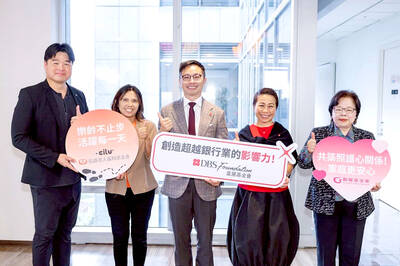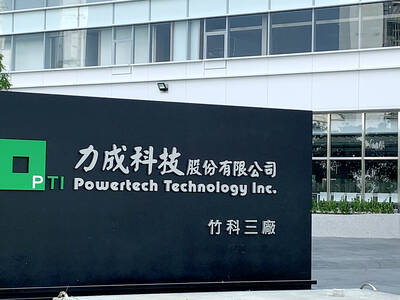Asustek Computer Inc (華碩) has delayed its annual launch of a flagship smartphone from April to July at the latest, mainly due to a quarter-long shortage in key components, company executives said yesterday.
Persisting supply constraints on key components and volatility in foreign currency exchange rates would be the two main challenges for Asustek this year, company chief executive officer Jerry Shen (沈振來) told an investors’ conference at the company’s headquarters in Taipei.
The company in November last year told reporters that it hoped to launch its next-generation ZenFone in April this year at the earliest, in an effort to maintain sales momentum, as the ZenFone 3 series product life cycle dissipates toward the end of the first half.
However, shortages in key components have affected Asustek’s plan, Shen said, declining to elaborate on the potential effect on the company’s smartphone business.
The affected components include DRAM, flash memory and flat panels that are used in both notebooks and smartphones, Asustek said.
The component shortages would increase manufacturing costs for Asustek, as component prices rise, industry analysts said.
To cope with rising manufacturing costs, Shen said the company has increased the retail prices for some of its notebook models in selected markets and also plans to hike prices for new models.
With the supply of key components tight, Asustek is to allocate their use to high-margin notebooks such as gaming and two-in-one detachable or convertible products to ensure that the company’s margins remain stable, chief financial officer Nick Wu (吳長榮) said.
Asustek forecast that the proportion of its revenues it gains from its PC business this quarter would drop to 15 percent, from last quarter’s 20 percent, while mobile business revenue would fall by between 10 percent and 15 percent due to seasonal weakness, Wu said.
Looking forward, Shen said Asustek this year hopes to ship close to last year’s 20.61 million PCs.
Revenue from the firm’s PC business is expected to grow mildly year-on-year on the back of increasing sales contributions from higher-priced gaming and two-in-one notebooks, Shen said.
The company last year reported a combined net income of NT$19.2 billion (US$624.08 million), representing NT$25.9 per share, 12 percent higher than 2015’s NT$17.09 billion, or NT$23 per share, company data showed.
Gross margin last year contracted 0.2 percentage points year-on-year to 13.6 percent, while operating margin fell 0.5 percentage points annually to 4.1 percent, the data showed.

US sports leagues rushed to get in on the multi-billion US dollar bonanza of legalized betting, but the arrest of an National Basketball Association (NBA) coach and player in two sprawling US federal investigations show the potential cost of partnering with the gambling industry. Portland Trail Blazers coach Chauncey Billups, a former Detroit Pistons star and an NBA Hall of Famer, was arrested for his alleged role in rigged illegal poker games that prosecutors say were tied to Mafia crime families. Miami Heat guard Terry Rozier was charged with manipulating his play for the benefit of bettors and former NBA player and

The DBS Foundation yesterday announced the launch of two flagship programs, “Silver Motion” and “Happier Caregiver, Healthier Seniors,” in partnership with CCILU Ltd, Hondao Senior Citizens’ Welfare Foundation and the Garden of Hope Foundation to help Taiwan face the challenges of a rapidly aging population. The foundation said it would invest S$4.91 million (US$3.8 million) over three years to foster inclusion and resilience in an aging society. “Aging may bring challenges, but it also brings opportunities. With many Asian markets rapidly becoming super-aged, the DBS Foundation is working with a regional ecosystem of like-minded partners across the private, public and people sectors

BREAKTHROUGH TECH: Powertech expects its fan-out PLP system to become mainstream, saying it can offer three-times greater production throughput Chip packaging service provider Powertech Technology Inc (力成科技) plans to more than double its capital expenditures next year to more than NT$40 billion (US$1.31 billion) as demand for its new panel-level packaging (PLP) technology, primarily used in chips for artificial intelligence (AI) applications, has greatly exceeded what it can supply. A significant portion of the budget, about US$1 billion, would be earmarked for fan-out PLP technology, Powertech told investors yesterday. Its heavy investment in fan-out PLP technology over the past 10 years is expected to bear fruit in 2027 after the technology enters volume production, it said, adding that the tech would

YEAR-END BOOST: The holiday shopping season in the US and Europe, combined with rising demand for AI applications, is expected to drive exports to a new high, the NDC said Taiwan’s business climate monitor improved last month, transitioning from steady growth for the first time in five months, as robust global demand for artificial intelligence (AI) products and new iPhone shipments boosted exports and corporate sales, the National Development Council (NDC) said yesterday. The council uses a five-color system to measure the nation’s economic state, with “green” indicating steady growth, “red” suggesting a boom and “blue” reflecting a recession. “Yellow-red” and “yellow-blue” suggest a transition to a stronger or weaker condition. The total score of the monitor’s composite index rose to 35 points from a revised 31 in August, ending a four-month